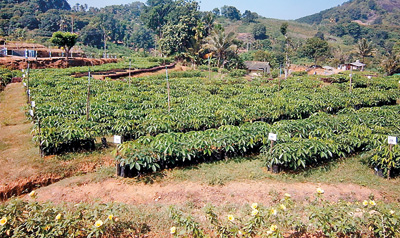Cultivating rubber in the north
 According to a news item in the Business Times last week, Rubber Research Institute (RRI) is going to cultivate large extents of rubber in non-traditional areas such as Vavuniya, Mulativu, Hambantota, and Puttalam . Rubber plays a very important role in the economy of the country. In the year 2014 this sector earned nearly Rs. 6 billion in foreign exchange. At present around 99,000 ha is under rubber and about 65 per cent of rubber lands are cultivated by small holders. The total production of rubber production has decreased from the year 2011 .
According to a news item in the Business Times last week, Rubber Research Institute (RRI) is going to cultivate large extents of rubber in non-traditional areas such as Vavuniya, Mulativu, Hambantota, and Puttalam . Rubber plays a very important role in the economy of the country. In the year 2014 this sector earned nearly Rs. 6 billion in foreign exchange. At present around 99,000 ha is under rubber and about 65 per cent of rubber lands are cultivated by small holders. The total production of rubber production has decreased from the year 2011 .
Global surplus may depress rubber prices through 2016 as maturing trees boost production and slowing growth reduces demand in China, the biggest consumer. Due to fall in rubber prices and increasing COP, many rubber small holders have given up rubber cultivation. There is a shortage of rubber tappers which drastically affects rubber industry. These data indicate that the rubber sector is deteriorating. The areas which RRI is proposing to cultivate rubber are in the dry and arid zones of the country and are not suitable for rubber mainly from the point of view of the rainfall requirement of this crop.
The ideal annual rainfall for rubber is in the range of 1650 mm – 2500 mm reasonably uniformly distributed throughout the year. The traditional rubber areas in Sri Lanka such as Kalutara, and Kegalle districts get a well distributed annual rainfall of 2000mm-3000mm. The annual rainfall in the areas which RRI is proposing to cultivate rubber is around 1000- 1500 mm and most of it comes during October to February. The other months are relatively dry. Under such climatic conditions is futile to grow rubber.
Instead of trying to grow rubber in unsuitable areas, what RRI needs to do is to pay more attention to grow rubber in areas which are more suitable to grow this crop. It is also necessary to examine the reasons for decreasing productivity of rubber in areas where it is already cultivated and take appropriate action.
(The writer can be reached at csweera@sltnet.lk)


